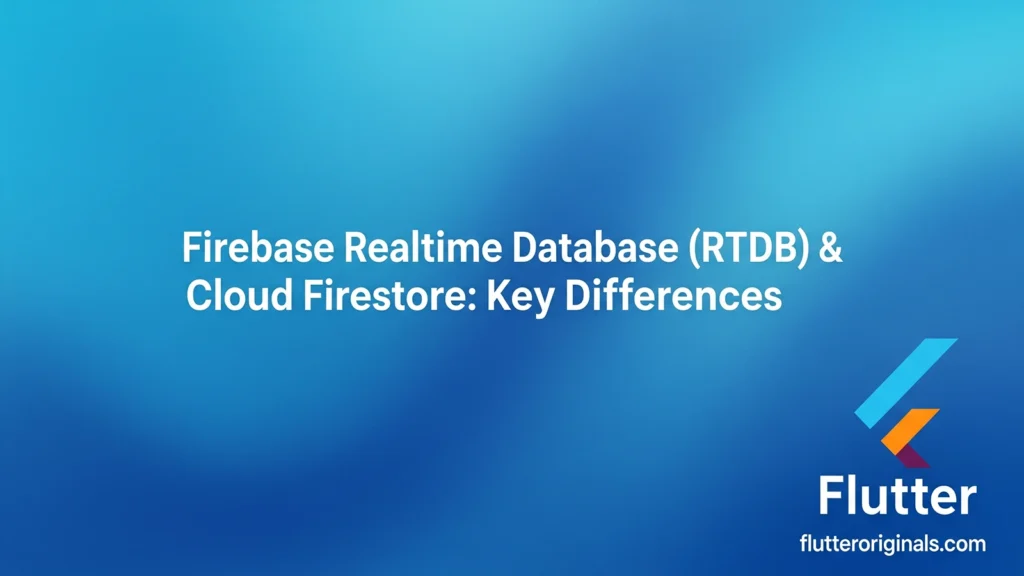
Choosing the right database is crucial for your application’s success. Firebase offers two powerful NoSQL options: the Firebase Realtime Database (RTDB) and Cloud Firestore. Both provide real-time data synchronization, but they are architecturally distinct and suited for different use cases.
Here is a detailed breakdown focusing on key technical and business considerations to help you make an informed decision.
1. Data Structure and Modeling
The foundational difference lies in how data is structured, which impacts data organization and query efficiency.
| Feature | Firebase Realtime Database (RTDB) | Cloud Firestore |
| Data Model | Giant JSON Tree (Single, monolithic structure) | Document-Collection Model (Hierarchical) |
| Organization | Data paths look like URLs. Harder to manage complex, nested, or hierarchical data, often requiring extensive data flattening or denormalization. | Data is stored in Documents (key-value maps) grouped into Collections. Documents can contain Subcollections, making it easy to model complex, deeply nested, and relational data. |
| Data Size Limit | No local limit on write rates to individual pieces of data. | Documents have a 1MB size limit; high write rates to a single document are limited. |
| Best For | Very simple data structures, low-complexity applications. | Complex and evolving data structures, scalable enterprise applications. |
Key Takeaway: For modern apps requiring flexible, well-structured data, Cloud Firestore is superior due to its intuitive document-collection model.
2. Querying Capabilities
A primary reason developers prefer Firestore is its advanced querying.
| Feature | Realtime Database (RTDB) Queries | Cloud Firestore Queries |
| Query Depth | Deep Queries (Always returns the entire subtree of the queried node). This can lead to excessive data transfer and high bandwidth costs. | Shallow Queries (Only returns documents in the specified collection or collection group). This saves bandwidth and allows for more efficient fetching. |
| Filtering/Sorting | Limited. Can only filter or sort on a single property at a time. | Powerful and Rich. Supports compound queries, chaining multiple filters and orderBy clauses (with the help of indexes). |
| Performance | Performance degrades as the size of the data set grows. | Queries scale with the size of your result set, not your data set, ensuring fast performance even with massive databases. |
Key Takeaway: For any application requiring sophisticated filtering, sorting, or data retrieval (e.g., e-commerce, social feeds), Cloud Firestore is the clear winner for its rich query language and performance.
3. Scalability, Availability, and Reliability
Scaling is where Cloud Firestore truly shines as a globally distributed database.
| Feature | Realtime Database (RTDB) Scaling | Cloud Firestore Scaling |
| Scaling Model | Manual Sharding Required. Developers must manually split data across multiple databases (sharding) to scale beyond certain limits. | Automatic Scaling. Scales effortlessly and automatically. |
| Concurrency Limit | ≈ 200,000 concurrent connections. | ≈ 1,000,000 concurrent connections. |
| Reliability | Regional Solution with zonal availability. ≈99.95% uptime guarantee. | Regional and Multi-Region Solution with data housed across multiple data centers. ≈99.999% uptime guarantee (multi-region). |
| Latency | Extremely Low Latency (≈10 ms). Ideal for immediate state-syncing. | Low Latency (≈30 ms). Excellent for most apps, but slightly higher than RTDB. |
Key Takeaway: For high-availability and global scalability, especially for large user bases, Cloud Firestore is the enterprise-grade choice.
4. Pricing and Cost Model
The pricing models are fundamentally different and will dramatically affect your monthly Firebase billing.
| Feature | Realtime Database (RTDB) Pricing | Cloud Firestore Pricing |
| Primary Cost Factor | Bandwidth (GB downloaded) and Storage (GB stored). | Operations (number of reads, writes, and deletes). |
| Cost Implication | Great for apps with low daily usage but high bursts of activity. Can be expensive if you have a lot of users and a lot of data downloaded. | Highly predictable for common usage patterns. Can be expensive if your app performs a massive number of small reads/writes (e.g., constantly updating every pixel on a screen). |
| Free Tier | Generous free quota for storage and connections. | Generous free quota for operations. |
Key Takeaway: Analyze your app’s usage: Cloud Firestore is better if you have high storage but low reads/writes. RTDB is better for high reads/writes and low total data storage/download.
Conclusion: Which Database Should You Choose?
| Use Case Category | Recommended Database | Rationale |
| Complex Applications | Cloud Firestore | Better data modeling, rich querying, and automatic scaling. |
| Simple Real-Time | Realtime Database | Extremely fast, low-latency data updates for basic state syncing. |
| Global Scale / Enterprise | Cloud Firestore | Multi-region availability and higher uptime guarantee. |
| Sophisticated Reporting | Cloud Firestore | Powerful queries reduce the need for denormalization. |
| Real-time Presence | Realtime Database | Native support for tracking user online/offline status. |
General Recommendation for New Projects: Cloud Firestore is the recommended database for all new projects, as it addresses most of the scalability and querying limitations of the older Realtime Database.
